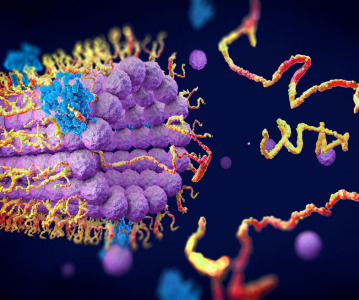Study paves way to design drugs aimed at multiple protein targets at once
An international research have developed a way to efficiently and effectively make designer drugs that hit multiple protein targets at once.
An international research collaboration led by scientists at the University of North Carolina School of Medicine and the University of Dundee, in the U.K., have developed a way to efficiently and effectively make designer drugs that hit multiple protein targets at once. This accomplishment, described in the Dec. 13, 2012 issue of the journal Nature, may prove invaluable for developing drugs to treat many common human diseases such as diabetes, high blood pressure, obesity, cancer, schizophrenia, and bi-polar disorder.
These disorders are called complex diseases because each have a number of genetic and non-genetic influences that determine susceptibility, i.e., whether someone will get the disease or not.
"In terms of the genetics of schizophrenia we know there are likely hundreds of different genes that can influence the risk for disease and, because of that, there's likely no single gene and no one drug target that will be useful for treating it, like other common complex diseases," said study co-leader, Brian L. Roth, MD, PhD, Michael J. Hooker Distinguished Professor of Pharmacology in the UNC School of Medicine, professor in the Division of Chemical Biology and Medicinal Chemistry in the UNC Eshelman School of Pharmacy, and director of the National Institute of Mental Health Psychoactive Drug Screening Program.
In complex neuropsychiatric conditions, infectious diseases and cancer, Roth points out that for the past 20 years drug design has been selectively aimed at a single molecular target, but because these are complex diseases, the drugs are often ineffective and thus many never reach the market.
Moreover, a drug that acts on a single targeted protein may interact with many other proteins. These undesired interactions frequently cause toxicity and adverse effects.
"And so the realization has been that perhaps one way forward is to make drugs that hit collections of drug targets simultaneously. This paper provides a way to do that," Roth said.
The new way involves automated drug design by computer that takes advantage of large databases of drug-target interactions. The latter have been made public through Roth's lab at UNC and through other resources.
Basically, the researchers, also co-led by Andrew L. Hopkins, PhD in the Division of Biological Chemistry and Drug Discovery, College of Life Sciences, at the University of Dundee, in Scotland, used the power of computational chemistry to design drug compounds that were then synthesized by chemists, tested in experimental assays and validated in mouse models of human disease.
The study team experimentally tested 800 drug-target predictions of the computationally designed compounds; of these, 75 percent were confirmed in test-tube (in vitro) experiments.
Drug to target engagement also was confirmed in animal models of human disease. In a mouse model of attention deficit hyperactivity disorder (ADHD), mice missing a particular dopamine receptor engage in recurrent aberrant behaviors similar to what is seen in ADHD: distractibility and novelty seeking. "We created a compound that was predicted to prevent those recurrent behaviors and it worked quite well," Roth said.
The researchers then tested the compound in another mouse model where a particular enzyme for a brain neuropeptide is missing. Distractibility and novelty seeking also are behavioral features in these animals. And the drug had the same effect in those mice.
The new drug design process includes ensuring that compounds enter the brain by crossing the blood-brain barrier. These, too, were tested successfully in live animals.
According to Roth, pharmaceutical company chemists had suggested that the objective of a drug hitting multiple targets simultaneously is impossible and unlikely to succeed. "Here we show how to efficiently and effectively make designer drugs that can do that."
Along with Roth, the study's 21 co-authors include the following from UNC: Vincent Setola, Xi-Ping Huang and Maria F. Sassano. Other co-authors are from University of Dundee, Dundee, U.K.; Duke University Medical School, Durham, N.C.; Clinical Research Institute of Montreal, Montreal, Quebec, Canada; and the Swiss Federal Institute of Technology in Lausanne, Switzerland.
Part of the funding for the research comes from the National Institute of Health grants supporting drug discovery receptor pharmacology.
Related News
-
News A Day in the Life of a Start-Up Founder and CEO
At CPHI we work to support Start-Up companies in the pharmaceutical industry and recognise the expertise and innovative angles they bring to the field. Through our Start-Up Programme we have gotten to know some of these leaders, and in this Day in the ... -
News Biopharmaceutical manufacturing boost part of new UK government budget
In their national budget announced by the UK Labour Party, biopharmaceutical production and manufacturing are set to receive a significant boost in capital grants through the Life Sciences Innovative Manufacturing Fund (LSIMF). -
News CPHI Podcast Series: The power of proteins in antibody drug development
In the latest episode of the CPHI Podcast Series, Lucy Chard is joined by Thomas Cornell from Abzena to discuss protein engineering for drug design and development. -
News Amgen sues Samsung biologics unit over biosimilar for bone disease
Samsung Bioepis, the biologics unit of Samsung, has been issued a lawsuit brought forth by Amgen over proposed biosimilars of Amgen’s bone drugs Prolia and Xgeva. -
News CPHI Podcast Series: Why we need to consider women in clinical trials
The latest episode of the CPHI Podcast Series with Lucy Chard covers women's health, specifically women's representation in clinical trials, the associated bias, and the impacts on health for this population. -
News US FDA does not approve MDMA therapy for PTSD, requests more data
The MDMA-based therapeutic developed by Lykos Therapeutics, a California-based Public Benefit Corporation (PBC), has been reviewed and unapproved by the US FDA. The regulator has requested additional phase III trial data for further safety and efficacy... -
News Novartis and Viatris latest facing lawsuit over HeLa cell misuse
Global pharmaceutical companies Novartis and Viatris are the latest hit with a lawsuit claim pertaining to alleged misuse of the ‘HeLa’ cell line from the estate of woman whose cancerous tissue cells were taken without consent. -
News Sanofi invests billions into Frankfurt insulin production site
French pharmaceutical company Sanofi have announced an investment of EUR1.3 billion at their existing BioCampus site in Frankfurt am Main for the expansion of insulin production.
Position your company at the heart of the global Pharma industry with a CPHI Online membership
-
Your products and solutions visible to thousands of visitors within the largest Pharma marketplace
-
Generate high-quality, engaged leads for your business, all year round
-
Promote your business as the industry’s thought-leader by hosting your reports, brochures and videos within your profile
-
Your company’s profile boosted at all participating CPHI events
-
An easy-to-use platform with a detailed dashboard showing your leads and performance



.png)

.png)
.png)
.png)